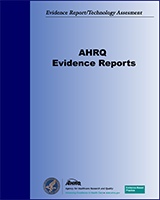NCBI Bookshelf. A service of the National Library of Medicine, National Institutes of Health.
This publication is provided for historical reference only and the information may be out of date.
Structured Abstract
Objectives:
This systematic review was undertaken to: (1) evaluate the accuracy of patient reporting of cancer family history, (2) identify and evaluate tools designed to capture cancer family history that are applicable to the primary care setting, and (3) identify and evaluate risk assessment tools (RATs) in promoting appropriate management of familial cancer risk in primary care settings.
Data Sources:
MEDLINE®, EMBASE®, CINAHL® and Cochrane Central® from 1990 to July 2007.
Review Methods:
Standard systematic review methodology was employed. Eligibility criteria included English studies evaluating breast, colorectal, ovarian, or prostate cancers. All primary study designs were included. For family history tools (FHxTs) and RATs, studies were limited to those applicable to primary care settings. RATs were excluded if they calculated the risk of mutation only, required specialist genetics knowledge, or were stand-alone guidelines.
Results:
Reporting Accuracy: Of 19 eligible studies, 16 evaluated the accuracy of reporting family history and three on reliability. Reporting accuracy was better for relatives free of cancer (specificity) than those with cancer (sensitivity). Accuracy was better for breast and colorectal than for ovarian and prostate cancers.
Family History Tools: Of 40 eligible studies, 18 FHxTs were applicable to primary care. Most collected information on more than one cancer, employed self-administered questionnaires, and favored paper-based formats to collate family information. Details collected were often focused on specific conditions and affected relatives. Eleven tools were evaluated relative to current practice and seven were not. Irrespective of study design, compared to best current practice (genetic interviews) and standard primary care practice (family history in medical records) the FHxTs performed well.
Risk Assessment Tools: Of 15 eligible studies, three RATs were identified for patient use and eight for use by professionals. They were presented in a range of computer-based and paper-based formats, and preliminary evidence indicated potential efficacy, but not definitive effectiveness in practice.
Conclusions:
Although limited in generalizability, informants reporting their cancer family history have greater accuracy for relatives free of cancer than those with cancer. Reporting accuracy may vary among different cancer types.
FHxTs varied in the extent of family enquiry depending on the tool's purpose. These tools were primarily developed as an integral part of risk assessment. The few tools that were evaluated performed well against both best and standard clinical practice.
A number of RATs designed for primary care settings exist, but evidence is lacking of their effectiveness in promoting recommended clinical actions.
Contents
Task Order Leaders: Nadeem Qureshi, MBBS, DM and Brenda Wilson, MB, ChB, MSc, MRCP(UK), FFPH.
Prepared for: Agency for Healthcare Research and Quality, U.S. Department of Health and Human Services.1 Contract No. 290-02-0020. Prepared by: McMaster University Evidence-based Practice Center, Hamilton, ON.
Suggested citation:
Qureshi N, Wilson B, Santaguida P, Carroll J, Allanson J, Ruiz Culebro C, Brouwers M, Raina P. Collection and Use of Cancer Family History in Primary Care. Evidence Report/Technology Assessment No. 159 (prepared by the McMaster University Evidence-based Practice Center, under Contract No. 290-02-0020). AHRQ Publication No. 08-E001. Rockville, MD: Agency for Healthcare Research and Quality. October 2007.
This report is based on research conducted by the McMaster University Evidence-based Practice Center (EPC) under contract to the Agency for Healthcare Research and Quality (AHRQ), Rockville, MD (Contract No. 290-02-0020). The findings and conclusions in this document are those of the author(s), who are responsible for its content, and do not necessarily represent the views of AHRQ. No statement in this report should be construed as an official position of AHRQ or of the U.S. Department of Health and Human Services.
The information in this report is intended to help clinicians, employers, policymakers, and others make informed decisions about the provision of health care services. This report is intended as a reference and not as a substitute for clinical judgment.
This report may be used, in whole or in part, as the basis for the development of clinical practice guidelines and other quality enhancement tools, or as a basis for reimbursement and coverage policies. AHRQ or U.S. Department of Health and Human Services endorsement of such derivative products may not be stated or implied.
None of the investigators has any affiliations or financial involvement that conflicts with the material presented in this report.
- 1
540 Gaither Road, Rockville, MD 20850. www
.ahrq.gov
